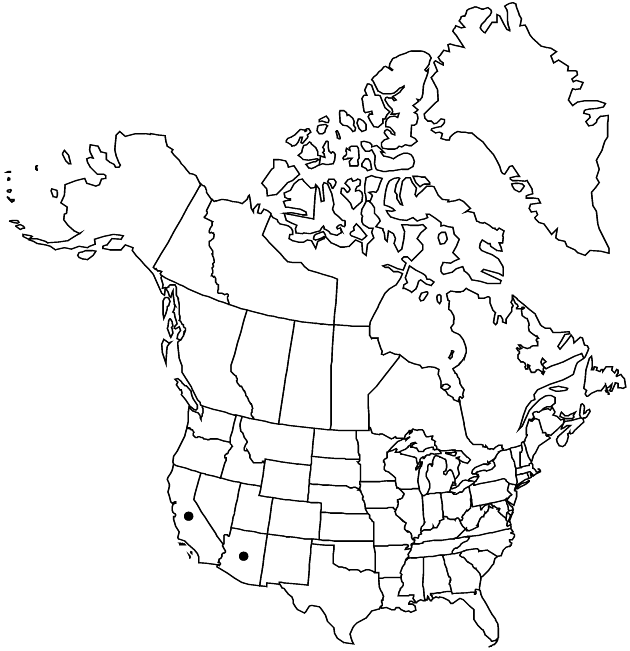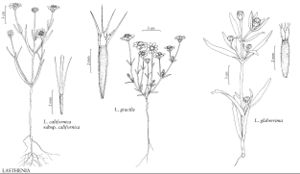Difference between revisions of "Lasthenia gracilis"
Man. Bot. San Francisco, 206. 1894.
FNA>Volume Importer |
FNA>Volume Importer |
||
| Line 8: | Line 8: | ||
}} | }} | ||
|common_names=Common goldfields | |common_names=Common goldfields | ||
| − | |basionyms={{Treatment/ID/ | + | |basionyms={{Treatment/ID/Basionym |
|name=Burrielia gracilis | |name=Burrielia gracilis | ||
|authority=de Candolle | |authority=de Candolle | ||
| + | |publication_title=in A. P. de Candolle and A. L. P. P. de Candolle, Prodr. | ||
| + | |publication_place=5: 664. 1836 | ||
}} | }} | ||
|synonyms={{Treatment/ID/Synonym | |synonyms={{Treatment/ID/Synonym | ||
| Line 33: | Line 35: | ||
|elevation=0–1500 m | |elevation=0–1500 m | ||
|distribution=Ariz.;Calif.;Mexico (Baja California;Sonora). | |distribution=Ariz.;Calif.;Mexico (Baja California;Sonora). | ||
| − | |discussion=<p>D. D. Keck (1959c) said of <i>Lasthenia gracilis</i> (as Baeria chrysostoma <i></i>subsp.<i> gracilis</i>), “The most abundant composite in the state [of California].” It is widespread throughout California, central Arizona, the Channel Islands, Guadalupe Island, and Baja California. It is variable and is sometimes similar to <i>L. californica </i>subsp.<i> californica</i>, from which it differs in its opaque, white, ovate-lanceolate, aristate pappus scales. Coastal forms of <i>L. gracilis</i> tend to have shorter, wider, fleshy leaves. <i>Lasthenia gracilis</i> often occurs with other <i>Lasthenia</i> species.</p> | + | |discussion=<p>D. D. Keck (1959c) said of <i>Lasthenia gracilis</i> (as Baeria chrysostoma <i></i></i>subsp.<i><i> gracilis</i>), “The most abundant composite in the state [of California].” It is widespread throughout California, central Arizona, the Channel Islands, Guadalupe Island, and Baja California. It is variable and is sometimes similar to <i>L. californica </i>subsp.<i> californica</i>, from which it differs in its opaque, white, ovate-lanceolate, aristate pappus scales. Coastal forms of <i>L. gracilis</i> tend to have shorter, wider, fleshy leaves. <i>Lasthenia gracilis</i> often occurs with other <i>Lasthenia</i> species.</p> |
|tables= | |tables= | ||
|references= | |references= | ||
| Line 57: | Line 59: | ||
|publication year=1894 | |publication year=1894 | ||
|special status= | |special status= | ||
| − | |source xml=https://jpend@bitbucket.org/aafc-mbb/fna-data-curation.git/src/ | + | |source xml=https://jpend@bitbucket.org/aafc-mbb/fna-data-curation.git/src/f6b125a955440c0872999024f038d74684f65921/coarse_grained_fna_xml/V19-20-21/V21_846.xml |
|tribe=Asteraceae tribe Heliantheae | |tribe=Asteraceae tribe Heliantheae | ||
|subtribe=Asteraceae (tribe Heliantheae) subtribe Baeriinae | |subtribe=Asteraceae (tribe Heliantheae) subtribe Baeriinae | ||
Revision as of 18:50, 24 September 2019
Annuals, to 40 cm. Stems erect or decumbent, usually branched distally (sometimes proximally in desert forms), ± hairy (more so distally). Leaves linear to oblanceolate, 8–40(–70) × 1–3(–6) mm, (± fleshy in coastal forms) margins entire or with 3–5+ teeth, faces ± hairy. Involucres campanulate or hemispheric, 5–10 mm. Phyllaries (persistent or falling with cypselae) 4–13 (in 1 series), ovate-lanceolate to oblong, ± hairy. Receptacles conic, muricate, glabrous. Ray florets 6–13; laminae oblong, 5–10 mm. Anther appendages deltate. Cypselae black to gray, ± linear, to 3 mm, glabrous or hairy; pappi usually of (2–)4(–6) opaque, white (aging to brown), ovate-lanceolate, aristate scales, sometimes 0. 2n = 16, 32.
Phenology: Flowering Feb–Jun.
Habitat: Mostly open sites (virtually all habitats)
Elevation: 0–1500 m
Distribution

Ariz., Calif., Mexico (Baja California, Sonora).
Discussion
D. D. Keck (1959c) said of Lasthenia gracilis (as Baeria chrysostoma subsp. gracilis), “The most abundant composite in the state [of California].” It is widespread throughout California, central Arizona, the Channel Islands, Guadalupe Island, and Baja California. It is variable and is sometimes similar to L. californica subsp. californica, from which it differs in its opaque, white, ovate-lanceolate, aristate pappus scales. Coastal forms of L. gracilis tend to have shorter, wider, fleshy leaves. Lasthenia gracilis often occurs with other Lasthenia species.
Selected References
None.
